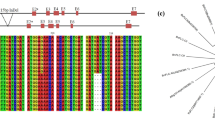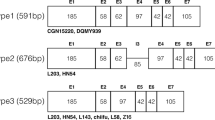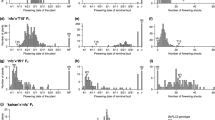Abstract
Key message
Nonsense-mediated mRNA decay (NMD)-mediated degradation of BrFLC2 transcripts is the main cause of rapid flowering of oilseed-type B. rapa ‘LP08’ plants.
Abstract
Many Brassica species require vernalization (long-term winter-like cooling) for transition to the reproductive stage. In the past several decades, scientific efforts have been made to discern the molecular mechanisms underlying vernalization in many species. Thus, to identify the key regulators required for vernalization in Brassica rapa L., we constructed a linkage map composed of 7833 single nucleotide polymorphism markers using the late-flowering Chinese cabbage (B. rapa L. ssp. pekinensis) inbred line ‘Chiifu’ and the early-flowering yellow sarson (B. rapa L. ssp. trilocularis) line ‘LP08’ and identified a single major QTL on the upper-arm of the chromosome A02. In addition, we compared the transcriptomes of the lines ‘Chiifu’ and ‘LP08’ at five vernalization time points, including both non-vernalized and post-vernalization conditions. We observed that BrFLC2 was significantly downregulated in the early flowering ‘LP08’ and had two deletion sites (one at 4th exon and the other at 3′ downstream region) around the BrFLC2 genomic region compared with the BrFLC2 genomic region in ‘Chiifu’. Large deletion at 3′ downstream region did not significantly affect transcription of both sense BrFLC2 transcript and antisense transcript, BrFLC2as along vernalization time course. However, the other deletion at 4th exon of BrFLC2 resulted in the generation of premature stop codon in BrFLC2 transcript in LP08 line. Cycloheximide treatment of LP08 line showed the de-repressed level of BrFLC2 in LP08, suggesting that low transcript level of BrFLC2 in LP08 might be caused by nonsense-mediated mRNA decay removing the nonsense transcript of BrFLC2. Collectively, this study provides a better understanding of the molecular mechanisms underlying floral transition in B. rapa.








Similar content being viewed by others
Data availability
NGS sequencing data were deposited into the Gene Expression Omnibus database (Accession Number GSE179970).
References
Amasino R (2010) Seasonal and developmental timing of flowering. Plant J 61(6):1001–1013. https://doi.org/10.1111/j.1365-313X.2010.04148.x
Andrews S (2010) FastQC.
Arciga-Reyes L, Wootton L, Kieffer M, Davies B (2006) UPF1 is required for nonsense-mediated mRNA decay (NMD) and RNAi in Arabidopsis. Plant J 47(3):480–489. https://doi.org/10.1111/j.1365-313X.2006.02802.x
Bolger AM, Lohse M, Usadel B (2014) Trimmomatic: a flexible trimmer for Illumina sequence data. Bioinformatics 30(15):2114–2120. https://doi.org/10.1093/bioinformatics/btu170
Brogna S, Wen JK (2009) Nonsense-mediated mRNA decay (NMD) mechanisms. Nat Struct Mol Biol 16(2):107–113. https://doi.org/10.1038/nsmb.1550
Broman KW, Wu H, Sen S, Churchill GA (2003) R/qtl: QTL mapping in experimental crosses. Bioinformatics 19(7):889–890. https://doi.org/10.1093/bioinformatics/btg112
Chang YF, Imam JS, Wilkinson MF (2007) The nonsense-mediated decay RNA surveillance pathway. Annu Rev Biochem 76:51–74. https://doi.org/10.1146/annurev.biochem.76.050106.093909
De Donato M, Peters SO, Mitchell SE, Hussain T, Imumorin IG (2013) Genotyping-by-sequencing (GBS): a novel, efficient and cost-effective genotyping method for cattle using next-generation sequencing. PLoS ONE. https://doi.org/10.1371/journal.pone.0062137
Dennis ES, Helliwell CA, Peacock WJ (2006) Vernalization: Spring into flowering. Dev Cell 11(1):1–2. https://doi.org/10.1016/j.devcel.2006.06.007
Drechsel G, Kahles A, Kesarwani AK, Stauffer E, Behr J, Drewe P, Ratsch G, Wachter A (2013) Nonsense-mediated decay of alternative precursor mRNA splicing variants is a major determinant of the Arabidopsis steady state transcriptome. Plant Cell 25(10):3726–3742. https://doi.org/10.1105/tpc.113.115485
Durand S, Cougot N, Mahuteau-Betzer F, Nguyen CH, Grierson DS, Bertrand E, Tazi J, Lejeune F (2007) Inhibition of nonsense-mediated mRNA decay (NMD) by a new chemical molecule reveals the dynamic of NMD factors in P-bodies. J Cell Biol 178(7):1145–1160. https://doi.org/10.1083/jcb.200611086
Elshire RJ, Glaubitz JC, Sun Q, Poland JA, Kawamoto K, Buckler ES, Mitchell SE (2011) A robust, simple genotyping-by-sequencing (GBS) approach for high diversity species. PLoS ONE. https://doi.org/10.1371/journal.pone.0019379
Ge SX, Jung DM, Yao RA (2020) ShinyGO: a graphical gene-set enrichment tool for animals and plants. Bioinformatics 36(8):2628–2629. https://doi.org/10.1093/bioinformatics/btz931
Geraldo N, Baurle I, Kidou S, Hu XY, Dean C (2009) FRIGIDA delays flowering in arabidopsis via a cotranscriptional mechanism involving direct interaction with the nuclear cap-binding complex. Plant Physiol 150(3):1611–1618. https://doi.org/10.1104/pp.109.137448
Herten K, Hestand MS, Vermeesch JR, Van Houdt JK (2015) GBSX: a toolkit for experimental design and demultiplexing genotyping by sequencing experiments. BMC Bioinform 16(1):1
Isken O, Maquat LE (2007) Quality control of eukaryotic mRNA: safeguarding cells from abnormal mRNA function. Genes Dev 21(15):1833–1856. https://doi.org/10.1101/gad.1566807
Kawanabe T, Osabe K, Itabashi E, Okazaki K, Dennis ES, Fujimoto R (2016) Development of primer sets that can verify the enrichment of histone modifications, and their application to examining vernalization-mediated chromatin changes in Brassica rapa L. Genes Genet Syst 91(1):1–10. https://doi.org/10.1266/ggs.15-00058
Kim DH (2020) Current understanding of flowering pathways in plants: focusing on the vernalization pathway in Arabidopsis and several vegetable crop plants. Hortic Environ Biote 61(2):209–227. https://doi.org/10.1007/s13580-019-00218-5
Kim DH, Sung S (2013) Coordination of the vernalization response through a VIN3 and FLC gene family regulatory network in Arabidopsis. Plant Cell 25(2):454–469. https://doi.org/10.1105/tpc.112.104760
Kim DH, Doyle MR, Sung S, Amasino RM (2009) Vernalization: Winter and the timing of flowering in plants. Annu Rev Cell Dev Bi 25:277–299. https://doi.org/10.1146/annurev.cellbio.042308.113411
Kim D, Pertea G, Trapnell C, Pimentel H, Kelley R, Salzberg SL (2013a) TopHat2: accurate alignment of transcriptomes in the presence of insertions, deletions and gene fusions. Genome Biol 14(4):R36. https://doi.org/10.1186/gb-2013-14-4-r36
Kim D, Pertea G, Trapnell C, Pimentel H, Kelley R, Salzberg SL (2013b) TopHat2: accurate alignment of transcriptomes in the presence of insertions, deletions and gene fusions. Genome Biol. https://doi.org/10.1186/gb-2013-14-4-r36
Kim JA, Kim JS, Hong JK, Lee YH, Lee SI, Jeong MJ (2017) Development of a marker system to discern the flowering type in Brassica rapa crops. J Plant Biotechnol 44:438-447. https://doi.org/10.5010/JPB.2017.44.4.438
Kitamoto N, Yui S, Nishikawa K, Takahata Y, Yokoi S (2014) A naturally occurring long insertion in the first intron in the Brassica rapa FLC2 gene causes delayed bolting. Euphytica 196(2):213–223. https://doi.org/10.1007/s10681-013-1025-9
Koornneef M, Blankestijndevries H, Hanhart C, Soppe W, Peeters T (1994) The phenotype of some late-flowering mutants is enhanced by a locus on chromosome-5 that is not effective in the landsberg erecta wild-type. Plant J 6(6):911–919. https://doi.org/10.1046/j.1365-313X.1994.6060911.x
Langmead B, Salzberg SL (2012) Fast gapped-read alignment with Bowtie 2. Nat Methods 9(4):357-U354. https://doi.org/10.1038/Nmeth.1923
Lee I, Michaels SD, Masshardt AS, Amasino RM (1994) The Late-flowering phenotype of Frigida and mutations in luminidependens is suppressed in the Landsberg erecta strain of Arabidopsis. Plant J 6(6):903–909. https://doi.org/10.1046/j.1365-313X.1994.6060903.x
Leijten W, Koes R, Roobeek I, Frugis G (2018) Translating flowering time from arabidopsis thaliana to Brassicaceae and Asteraceae crop species. Plants-Basel. https://doi.org/10.3390/plants7040111
Li F, Kitashiba H, Inaba K, Nishio T (2009) A Brassica rapa linkage map of EST-based SNP markers for identification of candidate genes controlling flowering time and leaf morphological traits. DNA Res 16(6):311–323. https://doi.org/10.1093/dnares/dsp020
Li XR, Zhang SF, Bai JJ, He YK (2016) Tuning growth cycles of Brassica crops via natural antisense transcripts of BrFLC. Plant Biotechnol J 14(3):905–914. https://doi.org/10.1111/pbi.12443
Liao Y, Smyth GK, Shi W (2014) featureCounts: an efficient general purpose program for assigning sequence reads to genomic features. Bioinformatics 30(7):923–930. https://doi.org/10.1093/bioinformatics/btt656
McKenna A, Hanna M, Banks E, Sivachenko A, Cibulskis K, Kernytsky A, Garimella K, Altshuler D, Gabriel S, Daly M (2010) The genome analysis toolkit: a MapReduce framework for analyzing next-generation DNA sequencing data. Genome Res 20(9):1297–1303
Nasim Z, Fahim M, Gawarecka K, Susila H, Jin S, Youn G, Ahn JH (2020) Role of AT1G72910, AT1G72940, and ADR1-LIKE 2 in plant immunity under nonsense-mediated mRNA decay-compromised conditions at low temperatures. Int J Mol Sci. https://doi.org/10.3390/ijms21217986
Nasim Z, Fahim M, Hwang H, Susila H, Jin S, Youn G, Ahn JH (2021) Nonsense-mediated mRNA decay modulates Arabidopsis flowering time via the SET DOMAIN GROUP 40-FLOWERING LOCUS C module. J Exp Bot 72(20):7049–7066. https://doi.org/10.1093/jxb/erab331
Osborn TC, Kole C, Parkin IAP, Sharpe AG, Kuiper M, Lydiate DJ, Trick M (1997) Comparison of flowering time genes in Brassica rapa, B-Napus and Arabidopsis Thaliana. Genetics 146(3):1123–1129
Questa JI, Song J, Geraldo N, An H, Dean C (2016) Arabidopsis transcriptional repressor VAL1 triggers Polycomb silencing at FLC during vernalization. Science 353(6298):485–488. https://doi.org/10.1126/science.aaf7354
Rayson S, Arciga-Reyes L, Wootton L, De Torres ZM, Truman W, Graham N, Grant M, Davies B (2012a) A role for nonsense-mediated mRNA decay in plants: pathogen responses are induced in Arabidopsis thaliana NMD mutants. PLoS ONE 7(2):e31917. https://doi.org/10.1371/journal.pone.0031917
Rayson S, Arciga-Reyes L, Wootton L, Zabala MD, Truman W, Graham N, Grant M, Davies B (2012b) A Role for Nonsense-Mediated mRNA Decay in Plants: Pathogen Responses Are Induced in Arabidopsis thaliana NMD Mutants. Plos One 7:2. https://doi.org/10.1371/journal.pone.0031917
Robinson MD, McCarthy DJ, Smyth GK (2010) edgeR: a Bioconductor package for differential expression analysis of digital gene expression data. Bioinformatics 26(1):139–140. https://doi.org/10.1093/bioinformatics/btp616
Schiessl SV, Huettel B, Kuehn D, Reinhardt R, Snowdon RJ (2017) Flowering time gene variation in brassica species shows evolutionary principles. Front Plant Sci 8:1742. https://doi.org/10.3389/fpls.2017.01742
Schweingruber C, Rufener SC, Zund D, Yamashita A, Muhlemann O (2013) Nonsense-mediated mRNA decay—mechanisms of substrate mRNA recognition and degradation in mammalian cells. Biochim Biophys-Gene Regul Mech 6–7:612–623. https://doi.org/10.1016/j.bbagrm.2013.02.005
Searle I, He YH, Turck F, Vincent C, Fornara F, Krober S, Amasino RA, Coupland G (2006) The transcription factor FLC confers a flowering response to vernalization by repressing meristem competence and systemic signaling in Arabidopsis. Gene Dev 20(7):898–912. https://doi.org/10.1101/gad.373506
Soundararajan P, Park SG, Won SY, Moon MS, Park HW, Ku KM, Kim JS (2021) Influence of genotype on high glucosinolate synthesis lines of Brassica rapa. Int J Mol Sci. https://doi.org/10.3390/ijms22147301
Sung S, Amasino RM (2004) Vernalization in Arabidopsis thaliana is mediated by the PHD finger protein VIN3. Nature 427(6970):159–164. https://doi.org/10.1038/nature02195
Sung S, Amasino RM (2005) Remembering winter: toward a molecular understanding of vernalization. Annu Rev Plant Biol 56:491–508. https://doi.org/10.1146/annurev.arplant.56.032604.144307
Swiezewski S, Liu FQ, Magusin A, Dean C (2009) Cold-induced silencing by long antisense transcripts of an Arabidopsis Polycomb target. Nature 462(7274):799-U122. https://doi.org/10.1038/nature08618
Teutonico RA, Osborn TC (1995) Mapping loci controlling vernalization requirement in Brassica rapa. Theor Appl Genet 91(8):1279–1283. https://doi.org/10.1007/Bf00220941
Thorvaldsdottir H, Robinson JT, Mesirov JP (2013) Integrative genomics viewer (IGV): high-performance genomics data visualization and exploration. Brief Bioinform 14(2):178–192. https://doi.org/10.1093/bib/bbs017
Wu J, Wei KY, Cheng F, Li SK, Wang Q, Zhao JJ, Bonnema G, Wang XW (2012) A naturally occurring InDel variation in BraAFLCb (BrFLC2) associated with flowering time variation in Brassica rapa. Bmc Plant Biol. https://doi.org/10.1186/1471-2229-12-151
Xiao D, Zhao JJ, Hou XL, Basnet RK, Carpio DPD, Zhang NW, Bucher J, Lin K, Cheng F, Wang XW, Bonnema G (2013) The Brassica rapa FLC homologue FLC2 is a key regulator of flowering time, identified through transcriptional co-expression networks. J Exp Bot 64(14):4503–4516. https://doi.org/10.1093/jxb/ert264
Yuan YX, Wu J, Sun RF, Zhang XW, Xu DH, Bonnema G, Wang XW (2009) A naturally occurring splicing site mutation in the Brassica rapa FLC1 gene is associated with variation in flowering time. J Exp Bot 60(4):1299–1308. https://doi.org/10.1093/jxb/erp010
Yuan W, Luo X, Li Z, Yang W, Wang Y, Liu R, Du J, He Y (2016) A cis cold memory element and a trans epigenome reader mediate Polycomb silencing of FLC by vernalization in Arabidopsis. Nat Genet 48(12):1527–1534. https://doi.org/10.1038/ng.3712
Zhao JJ, Kulkarni V, Liu NN, Del Carpio DP, Bucher J, Bonnema G (2010) BrFLC2 (FLOWERING LOCUS C) as a candidate gene for a vernalization response QTL in Brassica rapa. J Exp Bot 61(6):1817–1825. https://doi.org/10.1093/jxb/erq048
Acknowledgements
This research was supported by the Chung-Ang University Research Scholarship Grants in 2020 to S.K. This work was supported by grants from the BioGreen 21 Agri-Tech Innovation Program of the Rural Development Administration, Republic of Korea (Project No. PJ01566201) to J.A.K. and supported by a Grant from NRF (2021R1F1A1047822) to D.H.K.
Author information
Authors and Affiliations
Contributions
SK, JAK, and HK derived the RILs and performed the molecular experiments; SK, JAK, and DHK planned the experiments and analyzed the data; SK and DHK performed transcriptome analysis; DHK supervised and completed the writing.
Corresponding author
Ethics declarations
Conflict of interest
The authors declare that they have no conflict of interest.
Additional information
Publisher's Note
Springer Nature remains neutral with regard to jurisdictional claims in published maps and institutional affiliations.
Supplementary Information
Below is the link to the electronic supplementary material.
Rights and permissions
About this article
Cite this article
Kim, S., Kim, J.A., Kang, H. et al. A premature stop codon in BrFLC2 transcript results in early flowering in oilseed-type Brassica rapa plants. Plant Mol Biol 108, 241–255 (2022). https://doi.org/10.1007/s11103-021-01231-y
Received:
Accepted:
Published:
Issue Date:
DOI: https://doi.org/10.1007/s11103-021-01231-y




